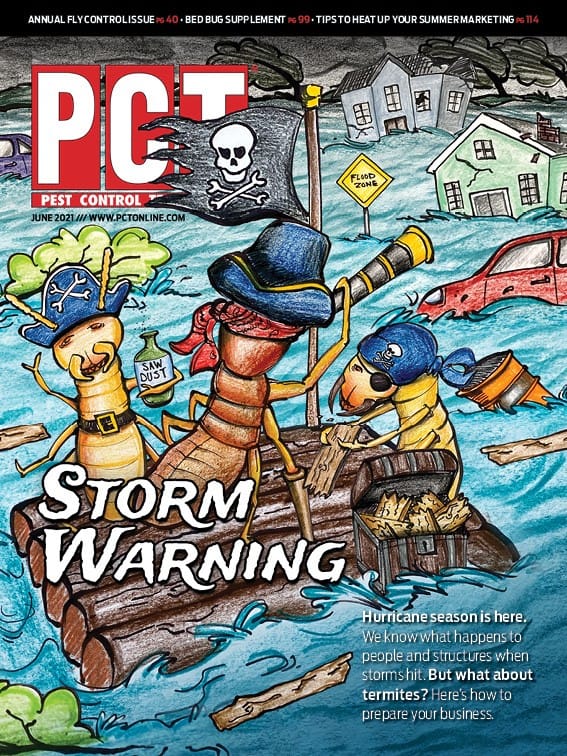
If there were ever a time when sanitation and a concern over cleanliness was top of mind, this is it. Winding down from a pandemic, the general public has been schooled in hand-washing, social distancing, mask-wearing and germs on surfaces. If something doesn’t look or feel clean, it’s a no-go. This heightened awareness puts pressure on businesses, particularly in the food industry.
“If you go into restaurants these days, people are so concerned about the appearance and cleanliness, so any kind of fly situation can put a black mark on them — and they are very conscious of it now,” says Bryan Baird, president, Baird’s Pest Control, Valdosta, Ga.
Not to mention, an especially wet year in Baird’s region is bringing out all the bugs. “It seems like the conditions are just right with the sanitation, wetness and people are more aware,” he says.

AJ Trevelen IV sees the same consumer attitudes, which is prompting some Sprague Pest Solutions customers to take their role in keeping small flies out more seriously. “Customer tolerance of anything that looks ‘gross’ is lower than it has ever been,” says Treleven, director of operations at the Tacoma, Wash.-based company. “What is acceptable is a lot different than it was pre-COVID, and it’s also more of a challenge to work with a manager or decision-maker who is not on site because they are limiting the number of people in a building.”
Does this mean a greater demand for small fly services or future growth in this sector? Baird believes so, and his account base of bars and restaurants — currently no more than 10 percent — is on the rise. “We are growing now,” he reports.
But not all pest management professionals who offer small fly services say there’s more interest, in spite of a public eye on keeping it clean. Sixty-one percent of respondents to PCT’s Small Fly Market Report Survey said the service is neither more nor less a significant part of their business. As for revenue potential, 66 percent expect no change and 29 percent predict an increase in revenues from selling small fly services in 2021.
That said, small fly complaints can bring in new business. Most of the PMPs we talked to said small fly struggles can trigger a call for service, and they acquire new accounts because a previous provider failed to get a problem under control.
In urban markets especially, Sprague Pest Solutions says it’s not uncommon for their sales team to walk into a situation where small fly efforts failed before. “There are so many factors in an urban market with garbage, alleys and the concentration of businesses,” Trevelen relates. “One building might have several restaurants in it and with how they feel about flies, the threshold is lower.”

Billy Blasingame, president, Blasingame Pest Management, Locust Grove, Ga., says his team does a “fair amount” of small fly work with current customers and has earned some new business because a former provider flopped. But what usually comes to the surface is an “a-ha” realization by the client that best practices for minimizing small fly pressure were not in place.
“Once we start working on the account and educate them, they are shocked and say, ‘We didn’t know that before,’” he says. “They are really surprised when we teach them about small flies and sanitation.”
What’s changed — and what has stayed the same in the small fly sector?
As our research and interviews indicate, education and training have always been paramount for treating small flies — along with a proper, thorough inspection, of course. Another constant is the type of account that is most likely to call about small flies: businesses in the food and beverage industry. And treatment protocols for managing small flies have remained consistent during recent years.

But all this doesn’t mean it’s the same-old with small flies. PMPs continue to fine-tune these processes, elevating communication with tools like pictures and giving hands-on lessons to teach clients what sanitation really is. They’re focusing even more on engaging customers because without buy-in, there are callbacks and cancellations.
Another change: Given the world we’ve been living in during the last year and a half, customers are accepting of strategies to maintain a safe and healthy environment. “With small flies comes odors related to drains and mopheads — it’s tangible to customers,” Blasingame says. “If you have small flies, you know it and your customers know it.”

Explore the June 2021 Issue
Check out more from this issue and find you next story to read.
Latest from Pest Control Technology
- Shop and SAVE on MasterLine only from Veseris
- What to Make of this Summer’s Dual Cicada Brood Emergence
- New to the List: Paul’s Termite & Pest Control
- PMPs in Some Areas of the U.S. Report Emergence of Cicadas
- Whitmore Rallies to Support Employee
- NPMA PestWorld 2024 Full Schedule Available
- Pest Control Sector PE Activity Up 18.8 Percent YOY, Capstone Partners Reports
- Backpack Mist Blowers for Mosquito Control





